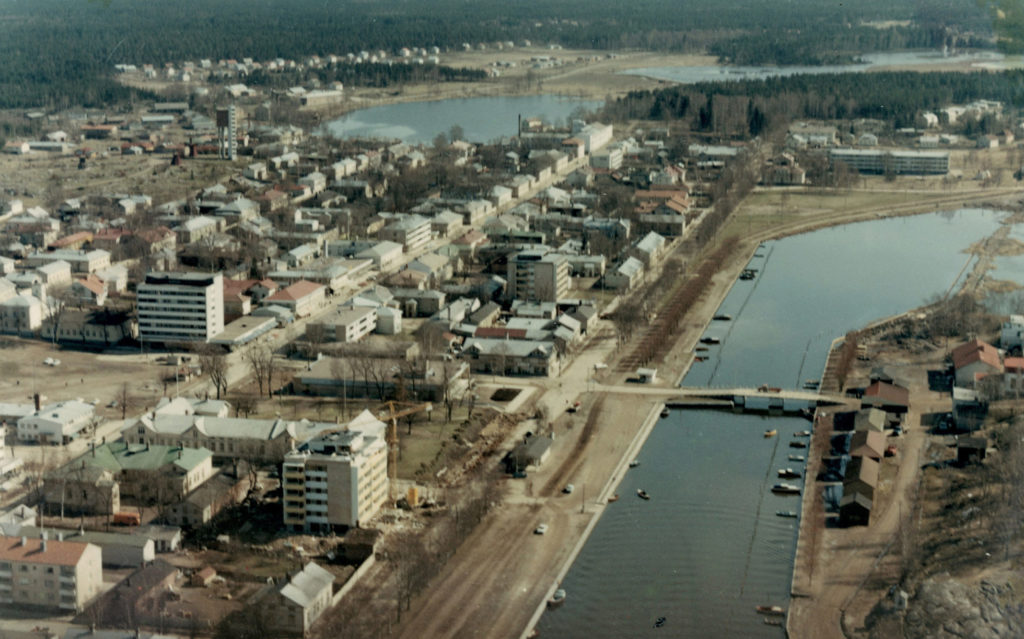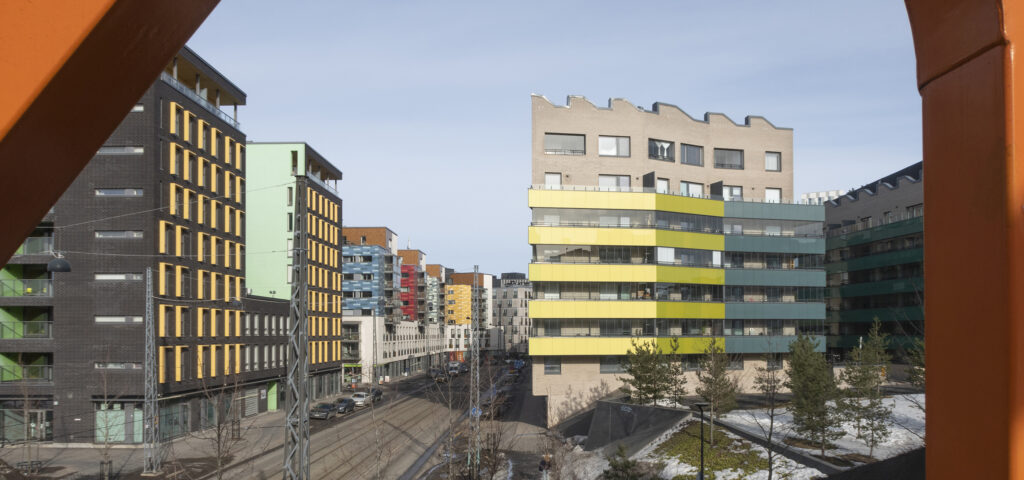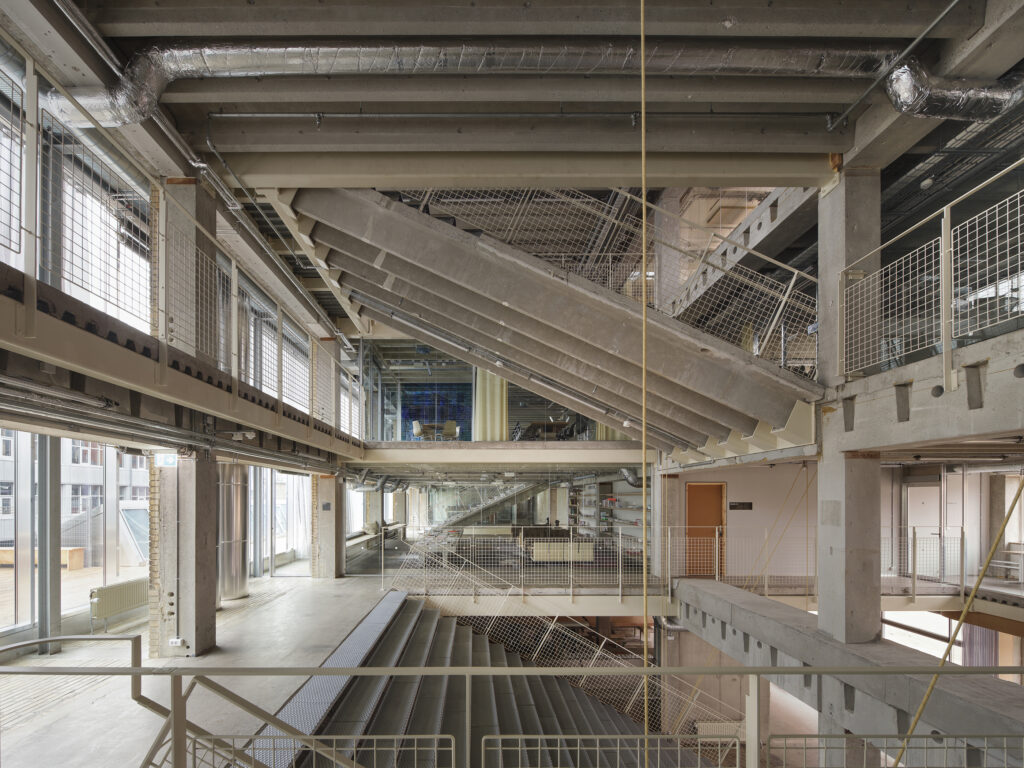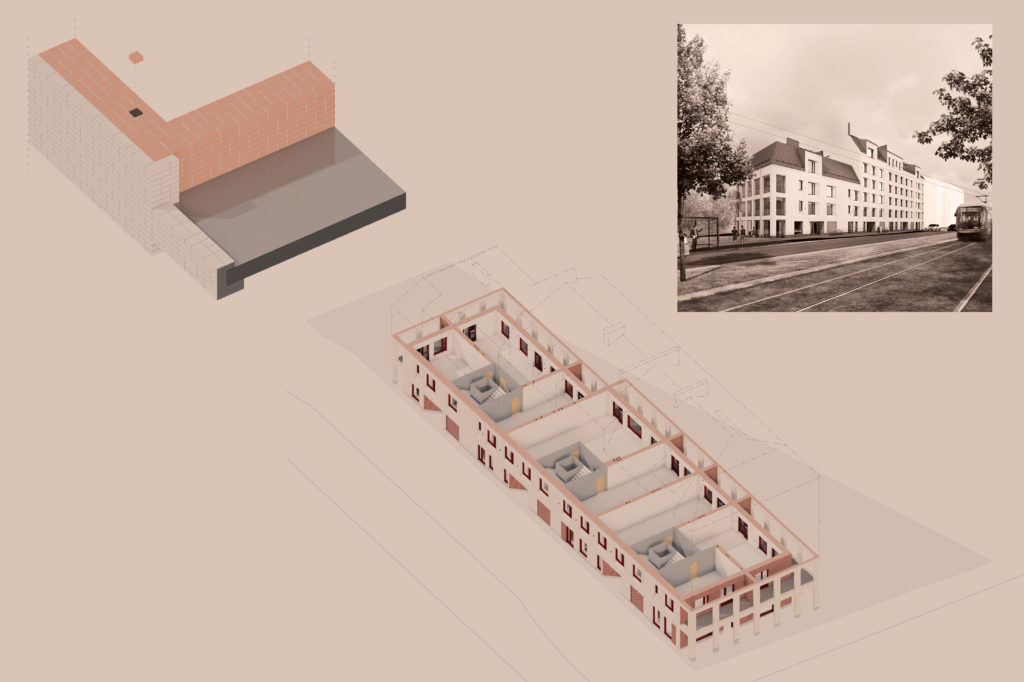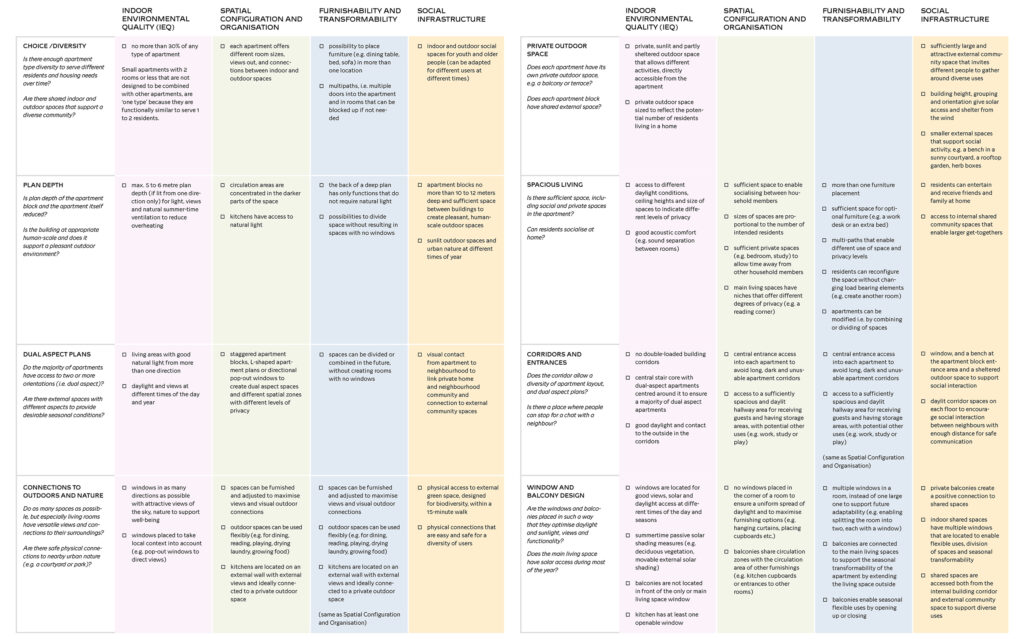Dramaturgy of Building and Ruin

If one examines an office building or shopping centre through the means of performing arts, what do they reveal about themselves, about architecture – and about the act of performing?
The mere thought of bringing architecture to the stage is an exciting notion. At first glance, architecture appears to pursue something permanent, unchanging and even eternal, whereas the very essence of the performing arts is transient and bound to a specific time. The way in which these two aspects come together in a live performance breeds a particular type of dramatic tension. In my recent works as a dramaturge, I have addressed precisely this tension and have sought to create dramaturgy with a play on time and materials. I have come to observe the cycle of novelty and decay, and how primarily it is our own perspective that distinguishes them from each other.
A stage piece entitled I was living in a strange place premiered in 2022. It was an examination of architecture through the means of a performance and was presented at the Baltic Circle theatre festival in Helsinki. The performance was brought to the stage in collaboration with a working group that I assembled – in addition to myself, the team included costume designer Hanne Jurmu, architect and researcher Kaisa Karvinen, actor Julia Lappalainen, sound designer and musician Nicolas “Leissi” Rehn, as well as lighting designer and scenographer Sofia Palillo.
With the obvious exception of Kaisa Karvinen, architecture was an unfamiliar world to all of us. Led by Karvinen, we took an eighteen-month deep dive into this subject matter, including the current critical issues revolving around architecture and the history of the discipline. I was living in a strange place engaged in a dialogue with a book of essays that had left a vivid impression on me, namely Rakenna, kärsi ja unhoita (“Build, suffer and forget”) by architect Helmi Kajaste. Through Kajaste’s writing, our performance delved deeper into the spaces created by books, the multifaceted significance of the home, and the worldviews communicated through architecture – as well as the dimension of time, the act of building and demolishing, the history of private and shared spaces, and concrete as a material.
Our stage piece was to be set in a deserted 1970s prefabricated concrete building. We referred to the set in slightly romantic terms as a modern ruin. However, even though Helsinki seems to be full of vacant, crumbling office buildings, finding a place to bring I was living in a strange place to life proved to be surprisingly difficult. Property owners preferred to keep their premises empty, with the hope of a potential long-term tenant showing up.
Finally, we got lucky. The vacant RTI building by the Finnish Broadcasting Company (Yle) offices in Pasila had been issued a demolition order, but the planning appeals made by the area’s residents had delayed the execution of the order. The owner saw an opportunity to bring new life, and thereby also potential tenants, into the building by allowing its use as a performance venue, and in November 2022, the entire Baltic Circle festival centre took residence in RTI building. During this intense period, the building’s large concrete hall was transformed into our home away from home. In the hectic weeks running up to the opening night, it was almost impossible to conceive that, in just one year, the building would no longer be there.
Demolition over renovation is in danger of becoming the standard practice of our time when it comes to buildings such as the RTI building. Associate Professor Panu Savolainen has defined a ruin as an amalgamation of oblivion, remembrance and the material world. Wreckage also occurs when something that is saturated with shared memories and meanings is willingly condemned to be lost and destroyed.
In the hectic weeks running up to the opening night, it was almost impossible to conceive that, in just one year, the building would no longer be there.
Urban Living at the Mall
I was living in a strange place had brought us to a modern ruin, but for my next project, I turned my gaze towards the concept of a shopping mall, which, up until very recently, was the epitome of newness. This, in my view, represents the first stage of a ruin: a building that manifests pure novelty.
The audio essay Vuosi kauppakeskuksessa (“A year at the mall”) was published in early 2024, produced by Yle’s Radiogalleria platform. I had my second child in 2022, and staying home with the baby was sometimes dull and lonely. I was itching to get out and be around people, but there were no street cafés, nor a library or similar meeting places in my neighbourhood in Helsinki’s Pasila. The new Mall of Tripla seemed to have absorbed all life from the surrounding area. In stark contrast, inside the shopping centre, I found an astonishing number of people just hanging out. After visiting Tripla almost daily for a full year, I was still struggling to wrap my head around the question, what on earth is this place? The burning question led to the creation of the audio essay in cooperation with sound designer Jani Orbinski.
I step inside the mall and lose track of time; time stops, ceases to exist. The tide of people, matter and events wraps itself around me, challenging my boundaries as an entity and blurring the temporal perspective. I come here to lose my place in time.
We began to unpack the illusion of an absence of history and perpetual novelty. We interviewed several experts on the fringes of the topic, explored shopping as a way of life and looked into the history of the new-generation shopping centres, in addition to examining their predecessors, the neighbourhood malls built during the 1960s–1980s, as well as the wave of demolition that has swept through them.
The new Mall of Tripla seemed to have absorbed all life from the surrounding area.
Where Does the Process of Ruin Begin?
While I was living in a strange place was performed in concert with not only the building but also the weather conditions and the changing seasons, the lack of such contextual factors is precisely what the shopping centre experience relies on. Here, “going out to be around people” refers to a temperature-controlled, air-conditioned, dry space whose lighting conditions remain unchanged irrespective of the time of day. A bird that has lost its way and flown inside the centre is a chirping glitch in the Matrix, while synthetic recordings of birdsong are playing in the restrooms at all hours.
In addition to the illusion of incessant novelty and detachment from time, a threat of desertification hangs over today’s shopping centres. Grocery and clothing purchases are exceedingly moving online, and the lack of walk-in customers means more and more vacant retail spaces at shopping centres. Roaming around Tripla with my tape recorder, I came across a number of empty shops and even entire vacant sections on the floors of the mall. Is Tripla the kind of future “dead mall” that we have seen in cautionary American examples?
The US is the birthplace of the shopping mall, but repeated economic slumps have meant that there has not been enough purchasing power to keep all of the malls alive, leaving behind a trail of deserted complexes. The internet is now awash with so-called “zombie mall” imagery. The gaming industry has produced an entire genre of deserted malls where the player can shoot and obliterate the living dead springing up from the ruins of capitalism.
Shopping malls are, therefore, facing immense pressure to reinvent themselves, and they are becoming exceedingly all-encompassing, immersive hubs of adventure, housing and living that people have little reason to ever leave. At Tripla, for instance, one can live in an apartment, go surfing and get married by a minister in a chapel. And yet, while shopping centres may give off an air of a small town, they are, in essence, commercial spaces. They are monitored by private security firms which define the permitted ways of being in the space. Art, even the most toothless kind, is rarely anywhere to be seen.
A Site-Specific Performance
The roots of a site-specific perfomance date back to 1960s situationism that generated new types of art, philosophy, activism and happenings. The international situationist movement originated in France and criticised consumerism, stagnant garden-variety art, utilitarian architecture and urban planning, as well as the ethos of economic growth as the primary goal of society. The members of the movement performed experimental urban interventions by, for example, navigating through Berlin using a map of Stockholm.
The situationists believed that a milieu and architecture has a much more profound effect on the human being than was conventionally considered. The criticism of architecture organically expanded into a more generalized social critique. This was, in my view, also the case with our performance. We highlighted aspects within the sphere of architecture such as housing and the home then turned the focus on how architecture defines the norm for a family unit. Our piece also included a discussion on the power dynamics and authority related to the construction business, as well as the type of green construction that comes across as greenwashing.
The 1960s situationists may have viewed death not from starvation, but from boredom as the greatest threat to society, but there has been a shift in perspective during the 21st century. Now, boredom appears to be a highly exclusive luxury. The themes covered in today’s situational live art include the acute dwindling of natural resources, the post-fossil era, neo-materialistic theories and the recognition of non-human co-actors.
We, too, posed the questions of how a building might be viewed as a performer and which materials made up our performance. First and foremost, however, we sought to deconstruct the concept of deconstruction. In contrast to the intangible dismantling of, say, concepts and norms, the tangible demolition that occurs within urban development does not appear to constitute a regenerative activity.
In contrast to the intangible dismantling of concepts and norms, the tangible demolition that occurs within urban development does not appear to constitute a regenerative activity.

Performative Concrete
One of the performers in our material-aware stage piece was concrete. We made a batch, it had its own solo, and architect-researcher Kaisa Karvinen gave the audience a brief lecture on the history of concrete.
We learned that, as our cities were expanding during the 1950s and 1960s, concrete enabled the rapid construction of entire city districts, gradually becoming the unspoken norm. In her lecture, Karvinen referred to the ideas of American architectural theorist Keller Easterling concerning the active forms of a city. According to Easterling, active forms are factors that guide or facilitate planning, such as building laws and regulations, building techniques, design tools or features of building components, which have at least an indirect impact on the generation of an urban environment. We wanted to illustrate to our audience that concrete is one of the most impactful elements in our cities, while also being an enormous energy glutton.
Buildings on the Cusp of Oblivion and Remembrance
After Helsinki, I was living in a strange place also toured the Hangö Teaterträff festival in Hanko and the ANTI festival in Kuopio, each time settling into a new abandoned building and its outdoor area. In Hanko, the performance took up residence in a half-empty shopping mall and in Kuopio, in a vacant commercial space located in a prefabricated concrete building which had been issued a partial prohibition of use. At each new venue, we were always faced with familiar elements: concrete columns, dusty laminate flooring, exposed aggregate concrete, low ceilings and strip windows. Bad indoor air and flowing space.
Despite the similarities, each building was a unique fellow performer that gradually became familiar with its perks and quirks. Each had their own caretaker, a person immersed in the features and secrets of that particular building. These dedicated people had accumulated years of experience in the buildings and knew exactly which corner to nudge to open a stiff door or how to locate an air-conditioning switch in a closet that no-one else had even noticed. They served as interpreters and liaisons between the working group and the building.
At the level of local government, however, there was an active effort to forget about these buildings, which meant that the caretakers’ job was now mostly palliative in nature. According to the Finnish Institute for Welfare and Health, the “key aspects in palliative and end-of-life care are relieving pain and other symptoms and responding to physical, social, psychological and spiritual needs. The care is multidisciplinary.” This is also one way of looking at our work. One of the buildings had already been condemned for demolition, and the rest were waiting for the final verdict. The essence of a ruin is linked to the tension between remembering and forgetting.
At each new venue, we were always faced with familiar elements: concrete columns, dusty laminate flooring, exposed aggregate concrete, low ceilings and strip windows.
Who Holds the Power to Wreck Buildings?
For us, as the authors of a live performance, the meaning of the piece begins to materialize in the small moments during the preparation and production process, but encountering the audience is always, inevitably, a significant occasion. The work becomes public and thereby also belongs to people outside the production crew. In a performance taking place without a specifically earmarked venue, the authors’ ownership of the work seems to be weaker and the relationship between the authors and the audience is stronger and more equal. We are all just visitors in the space. The audience steps into the building and, for a brief moment in time, looks at the space in a way that it has not been seen before. We also looked – and asked the following questions:
Where does the process of falling into ruin begin?
Does it begin in our gaze?
What can be demolished?
What can you build on?
There were people in the audience of I was living in a strange place who had no previous experience or perceptions of the building in question, whereas for some, the building may have been a familiar landmark on the daily route from their home to the grocery shop. For one audience member in Hanko, our performance was the first time they ever became aware of the building’s existence despite its location in the heart of the city.
One of the most memorable comments was made by a Ukrainian theatre curator, who stated that their country’s relationship with ruins had been completely transformed. The wreckage in Ukraine had transpired in a brief, violent turn of events, and there was no element of neglect or forgetting associated with these recent ruins – in fact, the opposite was true. A people, culture and an entire country can be ruined in a blink of an eye, as is now happening in Palestine. We are faced with a very different concept of modern ruin. It forces us to re-evaluate our original question, “What can you build on?”
Demolition is a Form of Conscious Forgetting
A stage piece is set in a specific space and time. It creates a profound spatial and corporal experience but is fated to disappear after the final applause.
Architecture seems to pursue permanence, but it is inevitably also tied to its own time and subject to the conditions it has created.
Work on protecting buildings is also an exercise of power par excellence – it is about deciding what shall be remembered and forgotten. With a demolition boom that systematically targets 1960s architecture, I cannot help but wonder what, exactly, is intended to be forgotten.
We need to learn to live with our existing buildings, and we need to create deeper meanings for them. This also applies to shopping centres. A degree of oblivion might be necessary, but we must also allow for space to generate more spontaneous ways of living and being in parallel with the forgetting. A delightful example of this is the (un)successful architecture of the Redi mall in Helsinki’s Kalasatama district, which is in the process of cultivating a steadily expanding filamentous network of circular economy, art and urban culture. At the very least, it is creating ways to fight back against the zombification of the complex.
While studying urban space through the lens of performing arts, I have come to realise that architecture amounts to much more than just the walls, floor and roof of a building. It provides a supporting frame for the human body, the body of an entire community. When this framework is crumbling down around us either in a sudden, violent flash or as a result of a systematic but short-sighted demolition project, we are also losing the cohesive structure holding up our community. The fast-paced cycle of construction always starts the process from zero, and people must begin the process of settling into a space that has no history of meaning.
Art creates meanings. A live performance that fails to reflect on its relationship with the performance space – or makes no other attempt to actively relate to the surrounding material reality and temporal context – is bound to become a fossilized reiteration of something that is old and conventional. Even new material is not always enough to produce something new and original. The opportunity of art to act as a force for creating new meanings is lost if it does not continue to question its own existence and explore the walls framing it. Today’s creators of site-specific art recognize the same threat in our time that the situationists saw in theirs: decay and ruin can also occur within the performing arts themselves. ↙
HENRIIKKA HIMMA
is a dramaturge and performance artist, who works with dramatic arts, radio and documentary film, and teaches at Uniarts Helsinki’s Theatre Academy. Current projects include a perfomance on modern church architecture and sacral space.
REFERENCES
Kaisa Karvinen: ”Betonista ja arkkitehtuurista”. Anti-zine 5.9.2023 antifestival.com/luento-betonista-ja-arkkitehtuurista/
Tommi Uschanov & Antti Arnkil: ”Johdatusta situationisteihin”, Niin & näin 3/2003.
Panu Savolainen: ”Muisti, rauniot, unohtaminen”, Niin & näin 4/2015.
Henriikka Himma & Jani Orbinski: Vuosi kauppakeskuksessa, Yle Radiogalleria 2024.
